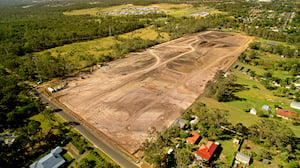What is a Site Plan? 10 Characteristics of a Good Site Plan to Set Your Next Development Up for Success
You can’t design a building until you know what the land can support. And you can’t determine what the land can support until you understand how a municipality’s regulations may impact your project.
Spatially laying out a construction project is more than drawing a building and some parking on a site. Existing infrastructure, the natural terrain, a town manager, and even local neighbors may all have something to say about your proposed development. And these moving parts can quickly become hard to track and incorporate into your project.
A quality site plan is the foundation of a successful project and a key step in the real estate development process - codifying all these requirements into a single construction document.
What is a site plan?
A site plan is a graphic representation of all existing and proposed improvements to a site. Sometimes referred to as a plot plan, the site plan functions as a map for a development project, incorporating all aspects of landscaping, construction, paving, utilities, and terrain features in a single depiction.
Site plans are important for several reasons. First, a site plan is almost always required for planning and development applications. Every municipality has its unique requirements for the plan review and approval process – the planning department will review a site plan to ensure it adheres to all applicable ordinances and development standards.
Second, the plan serves as a common operating picture and project roadmap for the development team. Capturing all major earthwork, site engineering, and construction elements on a single plan helps keep the efforts of the engineers, architects, general contractors, and developers aligned.
Lastly, a site plan is a critical tool to help with project budgeting. As a site is laid out graphically, engineering and construction requirements are identified, enabling a developer to better predict and plan for costs ahead of time.
The evolution of a site plan
Every construction project starts with some sort of sketch. Sometimes that’s done on the back of a napkin as you’re daydreaming about your next renovation or expansion project. Or maybe it’s a little more formalized - you pull the ruler and protractor out and sketch proposed improvements to scale.
In many commercial and large-scale residential real estate development projects, developers opt for a site sketch early in a project. The site sketch, or preliminary site plan, is an inexpensive way to begin to firm up some of the project unknowns. It's a critical first step to ensure the land entitlement process goes as smoothly as possible.
A civil engineer will layout the proposed site - their expertise is critical in capturing major civil engineering and site work elements, and applying municipal code.
The site sketch will help a real estate developer assess the feasibility of a project from both a land planning and density perspective.
It also helps in the creation and refinement of a preliminary development budget.
As the project takes form, it’s common to present the site sketch in a pre-application meeting to discuss the proposed plan.
The planning department and various interested parties will examine your site sketch and offer initial comments and considerations - changes to stormwater collection plans, emergency vehicle ingress and egress, proposed parking, and right-of-way improvements are typical discussion points.
After the pre-application meeting, a developer will have a better idea of whether to greenlight the project and proceed with further site evaluation work.
As the project progresses, that sketch is formalized into a site plan. Investigative activities like environmental assessments, boundary and topographic surveys, and soil studies further inform the finalization of the site plan.
Once all necessary tweaks have been made to a site plan, it is ready to undergo the site plan review process.
Characteristics of a good site plan
- Proper setbacks and buffers: Every municipality has a set of development standards that dictate the required spaces between buildings and property lines and the space between site improvements and certain terrain features. For example, you can't build within a certain distance of jurisdictional wetlands or streams.
- Topography and terrain features: Topography plays an important role in the layout of a site and determining necessary site work (stormwater collection plans, grading requirements, retaining walls, etc.). And key terrain features (streams, wetlands, soils, etc.) will also impact the density and layout of a site.
- Effective utilization of space: Developers and civil engineers must be creative when building a site plan. Quality use of space is essential to maximizing the site’s yield for a particular user.
- Fire hydrants and emergency vehicle access: A new development must have adequate access for fire and emergency personnel. Municipal code also dictates the required fire hydrants and maximum allowable distance from buildings for new construction.
- Landscaping: The type and size of landscape features should be included in a site plan to address how they accompany and supplement other development features.
- Neighboring streets: A graphic depiction of how a proposed project incorporates into adjacent streets and existing infrastructure. A good site plan will also include the flow of traffic and any lights or stop signs.
- Dimensions and orientation of all proposed improvements: This shows where the actual physical vertical construction will take place on a site and its orientation relative to the parcel.
- Easements: A site plan should include all easements to delineate property features shared with another party, including utility easements, right-of-way easements, etc.
- Driveways and parking: A graphic depiction of and dimensions for any driveways and parking areas. Should include the number of parking spots and proposed traffic flow.
- Amenities and unique property features: Community amenities, open space, and communal areas should be depicted. Unique construction features like shipping docks and drive-in doors must also be incorporated to account for vehicular access, traffic flow, and infrastructure needs.
Marsh & Partners makes real estate development simple
The real estate development process is often not intuitive. Tasks and events must be sequenced appropriately to minimize risk, control costs, and keep projects on schedule.
And the siloed functions and expertise of the various outside consultants often make a project even more difficult.
Think about it.
A general contractor’s job is to build, while a civil engineer plans and draws. And while both may be experts in their craft, operating in a vacuum can lead to project missteps and cost overruns if not properly managed and coordinated.
Marsh & Partners offers owners representative and real estate consulting services depending on your project specifics and propensity for involvement.
Need some help with land planning and feasibility before you engage an engineer to build a complete site plan? Book some time on our calendar to discuss your project, and let’s start planning today!



